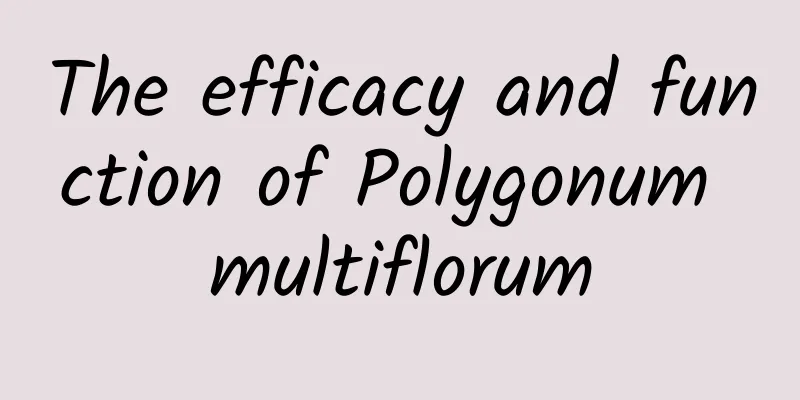The efficacy and function of Polygonum multiflorum

|
In modern life, everyone is very familiar with various Chinese herbal medicines, among which Polygonum multiflorum is a very common one. So what are the effects and functions of Polygonum multiflorum? Let’s take a look. 【English name】 RHIZOMA BISTORTAE [Other names] Purple ginseng, grass river cart, knife-cut medicine, copper Luo, shrimp ginseng, ground shrimp, mountain shrimp [Source] This product is the dried rhizome of Polygonum bistorta L., a plant of the Polygonaceae family. Dig it up when it sprouts in early spring or when the stems and leaves are about to wither in autumn, remove the mud and sand, dry it in the sun, and remove the fibrous roots. [Properties] This product is in the shape of a long flat strip or a flat cylinder and is curved, with slightly pointed ends or one end gradually tapering, and some are curled together, 6 to 13 cm long and 1 to 2.5 cm in diameter. The surface is purple-brown or purple-black, rough, with one side raised and the other side slightly flat or slightly grooved. The whole body is densely covered with coarse ring marks and has residual rootlets or root marks. It is hard, with a light brown or reddish brown cross section, and the vascular bundles are yellow-white dots arranged in rings. Odorless, bitter and astringent taste. 【Identification】 (1) The powder of this product is light brown-red. The cork cells are polygonal and contain brown-red substances. There are many calcium oxalate clusters, with diameters ranging from 15 to 65 μm. The diameter of the marginated pit ducts is 20 to 55 μm, and there are also reticular and spiral ducts. The fibers are long and fusiform, 10 to 20 μm in diameter, with thick walls, lignified, and obvious pores. Starch granules are elliptical, oval or quasi-circular, with a diameter of 5 to 12 μm. [Processing] Remove impurities, wash, soak briefly, moisten thoroughly, cut into thin slices, and dry. 【Nature and flavor】 Bitter, astringent, slightly cold. [entry into meridians] Enter the lung, liver and large intestine meridians. 【Functions and indications】 Clears away heat and detoxifies, reduces swelling and stops bleeding. Used for dysentery, hot diarrhea, lung heat cough, carbuncle, scrofula, mouth and tongue ulcers, vomiting blood, epistaxis, hemorrhoidal bleeding, and snake bites. 【Usage and Dosage】 4.5~9g. For external use, apply in appropriate amount. 【Storage】 Store in a dry place. 【Excerpt】 Chinese Pharmacopoeia 【Source】《Compendium of Materia Medica》 This article introduces to us what is Polygonum multiflorum. We know that Polygonum multiflorum has very high medicinal effects, but we must remind everyone that Polygonum multiflorum should generally not be eaten indiscriminately, otherwise it will cause serious consequences. I hope everyone will treat it with caution. |
<<: The efficacy and function of tangerine peel
>>: The efficacy and function of whole leaf blue orchid
Recommend
The high-speed rail speed exceeds 300 kilometers per hour, and wearing a seat belt is not safe!
Review expert: Wang Shengwei, Senior Engineer, Be...
The back of the moon has more craters than the front. Is it because it protects the Earth from meteorite impacts? This hypothesis is totally unfounded
The moon we see all year round has the same face....
Which is healthier, smelly stool or no smell? If you have this smell, beware of cancer
Expert of this article: Cheng KT, Master of Gener...
Can Poria powder be eaten every day?
Poria powder is a traditional Chinese medicine, b...
The Great Navigation 丨 "The Great Ming Unified Map": The world is so big, come and see it from here
The famous historical geographer Mr. Tan Qixiang ...
What are the effects and functions of Chuanbei Snow Pear?
We all like to eat pears. The pears from Laiyang ...
Benefits of Codonopsis for Pregnant Women
I believe everyone is familiar with Codonopsis pi...
20 satellites in one rocket! The successful launch of Jielong-3 injects new momentum into commercial aerospace!
At 3:24 on December 6, the Jielong-3 carrier rock...
The efficacy and function of Xian Banxia
In today's society, health preservation seems...
The efficacy and function of cedar leaf algae
We know that there are many kinds of Chinese medi...
Do you know all this about green printing?
As one of the four great inventions of ancient my...
Do mice like rice or cheese more?
Rats, commonly known as "mouse", are ma...
In order to stop having nightmares, I tried to make up a "good ending" for it, and it actually worked!
Generally speaking, if you have a good night'...
What is a "leopard print mango"? Can it be eaten? Can it be sold?
Recently someone recommended me a new thing calle...
The efficacy and function of Shenggu oil
Shenggu oil is a very common Chinese medicine in ...









